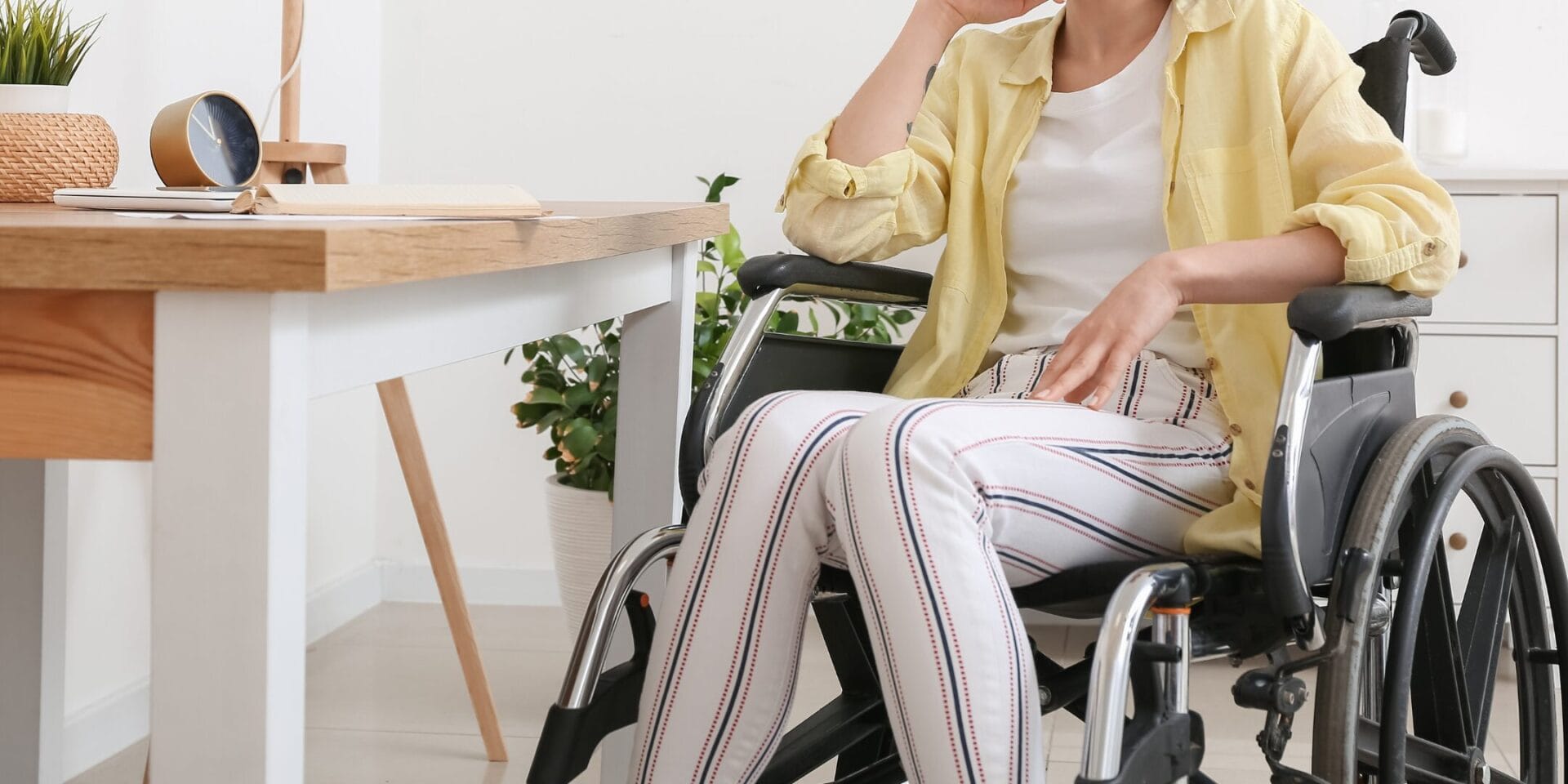Moving from hospital to home after sustaining a spinal cord injury (SCI) is a major life transition. With the right clinical foundations, personalised care, and community connections, people can not only live safely at home but also thrive. Our guide provides an overview of best practice considerations for commissioners, clinicians, and families supporting adults and children with SCI in community settings.
1) Start Well: A Safe, Person‑Led Pathway From Hospital to Home
- Early, joined‑up planning. Begin discharge planning on admission where possible. Align acute teams, specialist SCI centres, community services, and the chosen home‑care provider to one shared plan. Include clear timelines, responsibilities, and escalation routes.
- Single, personalised care and support plan. Co‑produce the plan with the person and their family, reflecting what matters to them, cultural preferences, routines, and outcomes. Use accessible formats and ensure consent/capacity is documented in line with the Mental Capacity Act (MCA) 2005.
- Competency‑based mobilisation. Where care is nurse‑delegated, deliver a structured programme of training, competency sign‑off, and supervised practice before go‑live. Shadowing shifts should include day and night routines, and preferably whilst the person is still in hospital to ensure a seamless transition of person-centred approaches to how their care is delivered.
- Home readiness. Complete environmental risk assessments; confirm equipment availability (beds, mattresses, hoists, slings, chairs), space for storage, safe medication systems, and emergency power continuity where technology‑dependent.
- Continuity and handover. Facilitate warm introductions and joint shifts with the hospital team; provide a clear clinical summary, prescriptions, and a 7‑day medication supply to bridge community set‑up.
2) Clinical Foundations for Safe Community Care
Skin integrity and tissue viability
- Comprehensive risk assessment (e.g., Waterlow/Braden per local policy) and a proactive repositioning schedule.
- Pressure‑relieving mattress and cushions matched to risk profile; daily skin checks embedded into routine care.
- Rapid escalation pathway to Tissue Viability services where indicated.
Autonomic dysreflexia (AD)
- Individual AD plan: Trigger avoidance (e.g., blocked catheter, constipation, tight clothing), symptom recognition, and an emergency protocol including when to call 999.
Respiratory care (including tracheostomy and ventilation)
- Baseline assessment and personalised airway clearance plan (e.g., suctioning, cough assist, chest physio).
- Safe tracheostomy care bundle where relevant, with spare tubes, emergency kit, and electricity contingency for ventilator users.
- Competency‑based training with regular refreshers and simulation drills.
Bowel and bladder management
- Catheter/ISC routines, fluid plans, and UTI prevention strategies.
- Structured bowel programme (timing, digital stimulation/suppositories/enemas as prescribed), with privacy and dignity at the forefront.
Pain, spasticity and tone management
- Multimodal plan (medication, stretches, positioning, heat/cold as appropriate) aligned with specialist advice; monitor for side effects and functional impact.
Posture, moving & handling
- 24‑hour postural care plan; sling choice and labelling; two‑carer or single‑handed care only where assessed safe.
- Regular reviews with Physiotherapy/Occupational Therapy (OT) to adjust seating, splints, and transfer technique.
Nutrition and hydration
- Dietetic input for weight management, wound healing, bowel health; PEG/enteral feeding where indicated with rigorous infection prevention and tube‑care protocols.
Medicines safety
- MAR charts or eMAR; PRN protocols; rescue medication escalation plan; homely remedies policy; clear stock control and disposal procedures.
Emergency readiness
- Individual Crisis & Escalation Plan including AD responses, trachy emergencies, seizure protocol (if relevant), and when to seek urgent care. Ensure accessible copies at home and with carers.
3) Governance, Training and Supervision
Nurse‑delegated model. Where tasks are delegated, providers should evidence robust policies, role boundaries, and ongoing clinical oversight. This includes:
- Structured initial and annual competency reviews.
- Supervisions and spot checks; reflective practice.
- 24/7 clinical on‑call and incident reporting/learning cycle.
- Duty of Candour and safeguarding pathways.
Information governance. Consent‑led sharing; secure record‑keeping; access to digital care records where preferred.
Quality assurance. Regular audits (care plans, MARs, pressure damage, infection control), outcome dashboards, and client feedback (PREMs) to drive improvement.
4) Home Environment, Equipment and Assistive Technology
- Accessible environment: level access, widened doorways, adapted bathroom, adequate turning circles, safe storage.
- Specialist equipment: profiling bed, hoists, commodes, shower chairs, pressure‑relieving cushions/mattresses, standing frames as clinically indicated.
- Wheelchair & seating: timely referral to Wheelchair Services; seating clinic reviews; power assist and driving adaptations.
- Environmental controls & smart home: voice control, switches, door openers, bed controls, heating/lighting automation.
- Telehealth & remote monitoring: where useful for ventilation parameters, skin checks, or wellbeing prompts.
- Power continuity: UPS or generator plans for life‑support equipment; tested and documented.
5) Holistic Outcomes: Living the Life You Choose
Personalised care and support planning is about more than tasks. It’s about identity, aspirations, and belonging. Consider:
- Mental wellbeing: trauma‑informed care; access to psychology and peer support groups; signposting to charities and lived‑experience networks.
- Identity, sexuality and relationships: sensitive, non‑judgemental support; privacy; access to sexual health services and adaptive solutions.
- Family and carer support: education, respite planning, emergency back‑up, and access to carers’ assessments.
- Physical activity & sport: connections to inclusive gyms, WheelPower, para‑sport clubs, and condition‑specific classes.
- Meaningful occupation: pathways back to education, work, or volunteering; vocational rehab; Access to Work funding.
6) Community Access and Participation
Thriving at home includes easy, confident access to community life:
- Transport: Blue Badge, Motability, wheelchair‑accessible vehicles (WAVs), community transport and travel training.
- Local assets: libraries, leisure centres, accessible parks, faith groups, and social prescribing via Primary Care Networks.
- Care team enablement: goal‑focused support for trips out, overnight stays, holidays, and events—underpinned by risk enablement rather than risk avoidance.
- Digital inclusion: devices, connectivity, and training to reduce isolation and support independence.
7) Outcomes and Measurement That Matter
Use a blended approach to evidence impact:
- Goal‑based: collaboratively set SMART goals linked to the person’s priorities (e.g., “attend weekly wheelchair rugby”, “reduce nighttime care from 2 to 1 call”). Review at least quarterly.
- Clinical outcomes: infection rates; pressure‑ulcer prevalence; UTI rates; hospital avoidance; ventilator parameters within range.
- Function & independence: tools such as Spinal Cord Independence Measure (SCIM) where suitable; therapy outcome measures agreed with the MDT.
- Experience & quality of life: Patient‑Reported Outcome/Experience Measures (PROMs/PREMs), the Canadian Occupational Performance Measure (COPM), and quality‑of‑life tools.
- Social outcomes: participation metrics (education/work/volunteering), community access frequency, and carer wellbeing scores.
8) Funding and Commissioning Pathways (England)
- NHS Continuing Healthcare (CHC) / Children & Young People’s Continuing Care: assessment, DST/CC components, and strong clinical rationales for nurse‑delegated complex care at home.
- Personal Health Budgets (PHBs) and Direct Payments: enable choice of provider and flexible support that fits routines and goals.
- Joint packages: align health and social care funding where appropriate, with clear governance.
9) A Positive Risk Approach
Enable autonomy through proportionate, dynamic risk assessments and clear boundaries. Document decisions, mitigations, and what a “good day” looks like. Review after any incident or change.
How Innovate Care Helps People Thrive at Home
At Innovate Complex Care Services we deliver complex care that combines specialist clinical oversight with truly personalised, nurse‑delegated support. We build small, stable teams around each person; train to competency; and focus relentlessly on outcomes that matter – safety, independence, and a life lived fully in the community.
Interested in co‑designing a home‑first package for someone with SCI?
- Bespoke clinical assessment and mobilisation plan
- Competency frameworks for tracheostomy/ventilation, bowel/bladder, and AD
- Outcome dashboards and transparent reporting for commissioners
- Proactive support for education, employment, sport and social participation
Contact us to start the conversation.
Editorial note: This article reflects UK community care best practice principles and is intended for general guidance. Individual needs will vary – please seek personalised clinical advice from the person’s specialist team.



